Ask the Pros: Split shots
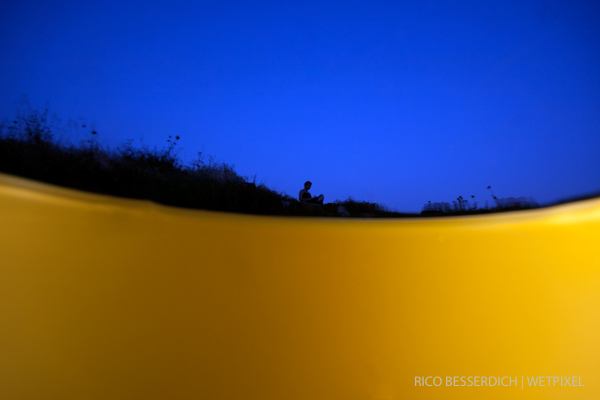
Rico Besserdich
Rico is a professional underwater photographer, artist & journalist. He has been involved in photography since 1978 and became specialized in underwater photography in 2001.
What is your favorite lens for shooting over/under images? Please specify whether you are shooting full frame or cropped sensor. What size dome port do you use?
I have taken over/under images with a few different lenses such as the Tokina 10-17mm, the Tokina 11-16mm, the Sigma 10-20 and the Canon 10-22mm, all on my cropped sensor camera. I am using a 8” dome port but have shot split shots with a 4,3” dome port as well.
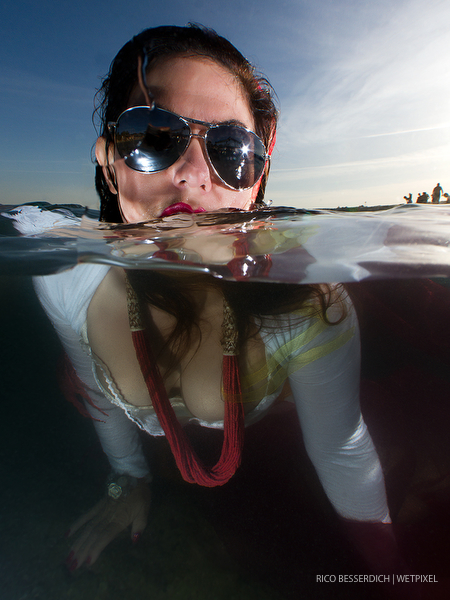
At the moment my favorite lens is the Canon 10-22mm.
How do you expose the images? Do you use tools in post to adjust either underwater or above water exposures?
Before dipping the camera in the water, I do a quick exposure measurment of the “over” area, just to make sure the sky (or whatever is there) looks OK. Of course, the underwater part will be too dark but I balance this with my strobe lights. Depending on the time of the day I often end up around f/13 to f/16, 1/80 to 1/125s and 100-200 ISO. If light is not sufficient I would rather use a higher ISO than changing my aperture & shutter speed settings.
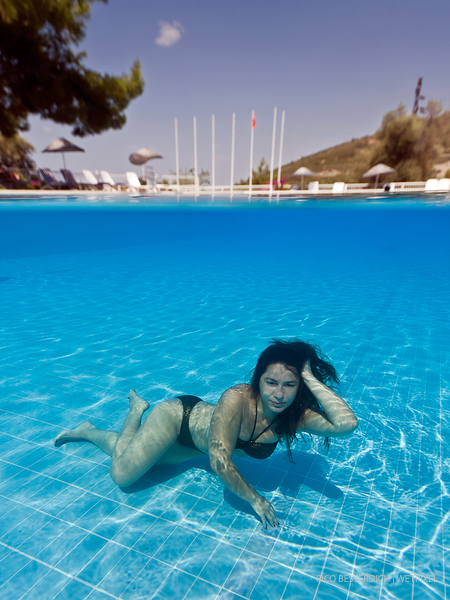
If I was unable to do things right in camera I sometimes apply a gradient filter (in Lightroom) to the “over” part to bring back contrast & structures in sky, clouds etc.
How do you shoot splits of fast moving animals?
I haven’t tried this yet.
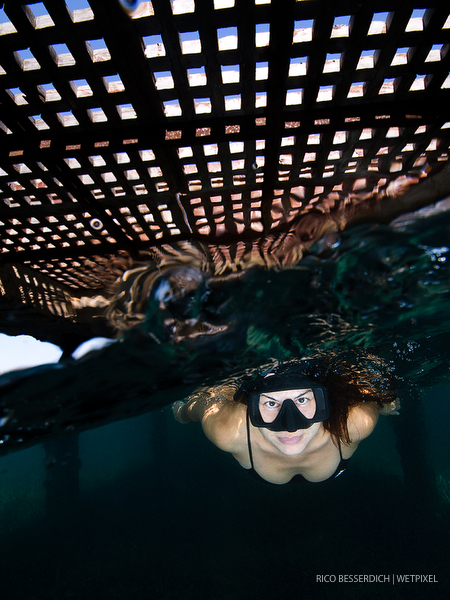
What makes for a great dive site for shooting over/unders? (Shallow reefs, sun angles etc.)
After working on over/under panorama shots while swimming without fins in the water, I honestly can say that shallow waters are the better choice, ha ha! It helps a lot to have a stable position while shooting split shots. Lying, sitting or standing on the bottom (if possible) works fine, floating “snorkeler’s style” on water surface stays as a plan B. Drifting around with full scuba gear I have never found drifting around with full scuba gear very suitable for shooting over/unders.
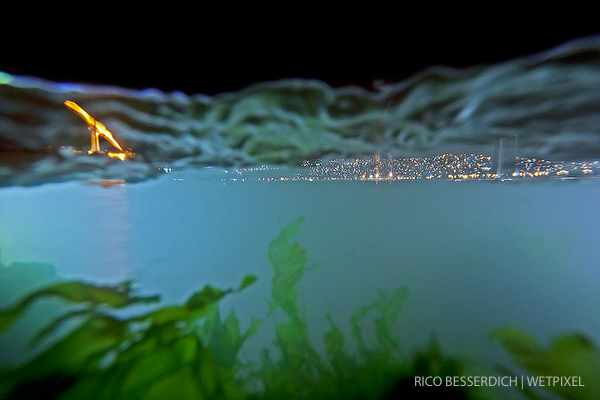
A good dive site for over/unders should have something interesting to capture in the over and under part alike. In my humble opinion, the perfect location is the one that allows to shoot an overwater/underwater interaction, like David Doubilet’s “Iceberg & Penguins” image, which I personally consider as one of the best over/unders ever made.
For the under part there is actually always something to shoot, but for the over part it needs to have some interesting subjects or structure (clouds, boats, people, beaches, buildings etc.) Or (the way I often like to work) you just focus on light and color patterns/contrasts. In my opinion this works well, too.
Quietness could be of use as well. I remember working on split shots in my hometown whilst being surrounded by many curious people with many curious questions. Some of them even tried to serve me food, taking off their pants, trying to reach me in the water (very nice move but also a bit disturbing if you try to concentrate on something tricky). So, a quiet place where you can spend an hour or two, where you need no scuba gear and which has something to show under and above the water might be the right one. Let’s add the interaction between the 2 elements (water & air) and have someone around who serves you snacks and drinks, because: a good over/under shot really needs its time ;-)

Why do you think over/unders are so popular with people? Do your split level shots sell well? In turn, do you set out to shoot them specifically for this?
Over/unders show 2 different worlds in one image, so they have something to offer for non-divers and divers alike.
My split shots are not for sale as I believe they are yet not good enough.
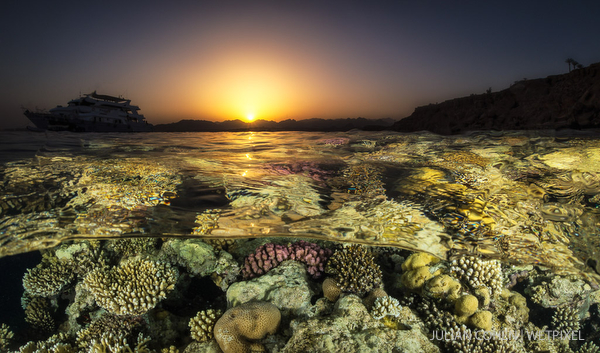
Julian Cohen
Julian Cohen is constantly traveling and rarely without a camera. He likes flowers and puppies and longs for world peace.
What is your favorite lens for shooting over/under images? Please specify whether you are shooting full frame or cropped sensor. What size dome port do you use?
I shoot full frame on a Nikon D4 so for over/unders I use either the Nikon 16mm or the Sigma 15mm with a Seacam superdome. The bigger the dome the better.
How do you expose the images? Do you use tools in post to adjust either underwater or above water exposures?
I expose for correct exposure above water at a high F stop, something like f16 or 18 to get the required depth of field. Then focus for the underwater subject and the depth of field keeps the air subject in focus. I use post processing to help with any minor exposure difference problems, but I almost always light the underwater subject with strobes to help balance the final image, as the exposure for above will usually be too dark for below. Keeping water droplets from the dome is the really tricky part. Everyone has their own patented method from Windex to rubbing it with half a potato, but I try to clean the dome before going out, then dip it in the water and raise it, watch for the water as it falls away, then shoot. Mostly with the new tools in Photoshop I can then clean away any errant droplets.

How do you shoot splits of fast moving animals?
I would pretty much do the same method as I described earlier. It is more challenging to balance the rig in deeper water but the main points of exposure and focus will apply whatever you are shooting. If you need to throw more strobe light then you can sacrifice with a higher ISO or a lower f stop and then use a graduated filter in post to bring back any overexposed areas in the over part of the image.
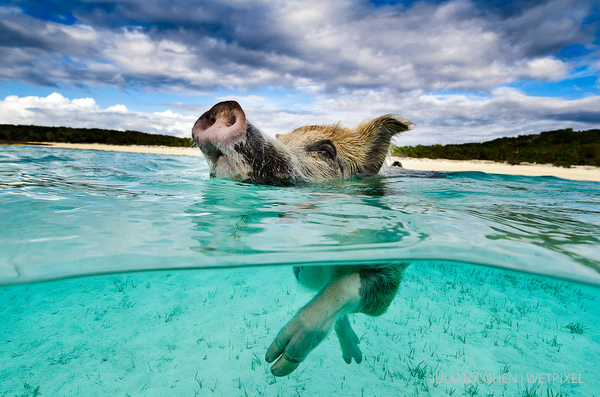
What makes for a great dive site for shooting over/unders? (Shallow reefs, sun angles etc.)
Shallow water is the best place, if you can stand then it’s even better. I often use an inflated BCD or a life jacket from the boat to rest the camera rig on, or hang off the side of a RIB as with the pigs in Exuma. Subject matter is very important, as it is with any image really, but there has to be something interesting both above and below the water to make a good image. Sunset shots are always great and I love to do them when I go to the Red Sea each year with Alex Mustard.
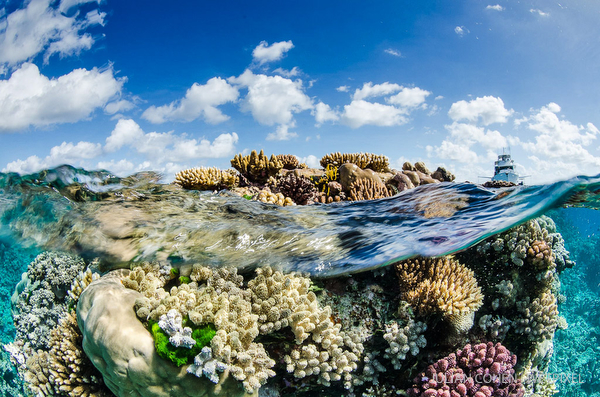
Why do you think over/unders are so popular with people? Do your split level shots sell well? In turn, do you set out to shoot them specifically for this?
I don’t really sell my images so I’m not the right person to ask about this, but I do think that for non divers being able to put an underwater subject in its context whilst seeing the land side as well is what gives the attraction. Plus often people think it’s really cool that you can get an image like that.
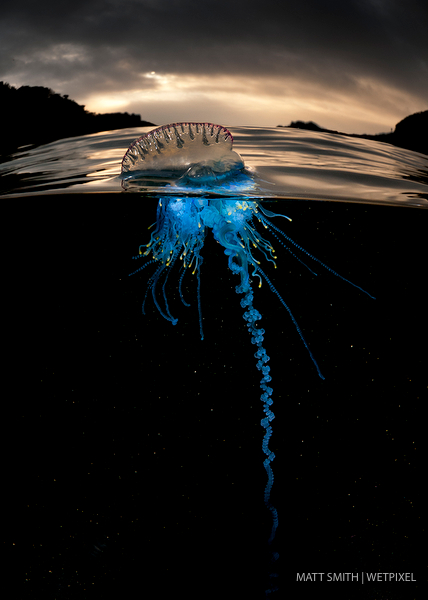
Berkley White
Berkley owns Backscatter Underwater Photo and Video and his images and technical articles are published in US and international dive magazines. He regularly serves as a photographic judge or technical editor in publications.
Shooting a high frame rate is essential to pulling off shots with both moving water lines and models. The split second diagonal movement of the wave is only possible to capture with a high frame and shooting a ton of shots.
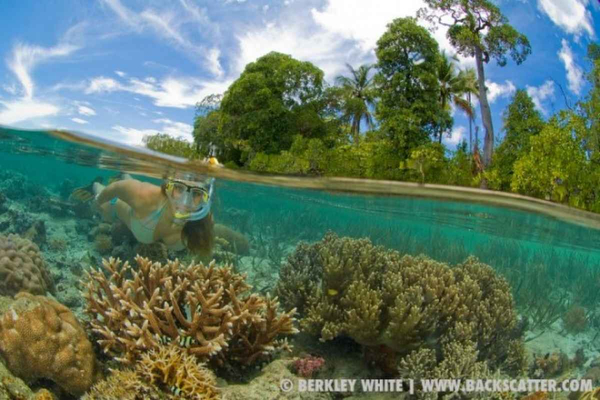
Non fisheye wide lenses typically need corrective optics to get both land and underwater in focus. While fisheye lenses do have a distorted look, they offer the greatest depth of field and the easiest method to get land and sea in focus. Altering the position of the lens with your composition or a slight crop on your final image can trim off any distracting curvature.
Large Dome Ports Help Smooth Out the Water
Even in flat sea conditions small ripples in the water can look like tsunamis through your lens. Large dome ports push these ripples further from your lens and help smooth out the waterline in your image. Large domes also make it easier to selectively place the water line in your image. I recommend a dome port of eight inches or larger for best results.
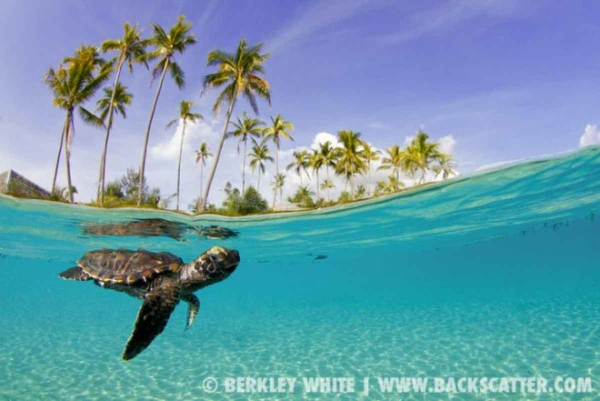
Use High Apertures for Best Depth of Filed (f16 or higher)
The optical characteristics of dome ports are demanding on your lens. No matter how far your underwater subject is away from you, your lens will need to capture a focus from about 18 inches to infinity. Use an aperture of f16 or higher to maximize your depth of field.
Use Fast Shutterspeeds (1/125 or higher)
As perviously discussed, the ripples on the surface have more impact than one might think. Fast shutter speeds will help freeze not just the motion of the waterline, but the inevitable wobbles of both the camera and your subject.
Shoot a Fast Frame Rate (5fps or higher)
After a little practice you’ll find that perfect compositions only last a split second. Lovingly known as the “spray and pray method,” high frame rates will dramatically increase your keeper ratio. Wait for the conditions to line up and then squeeze off a long machine gun burst.
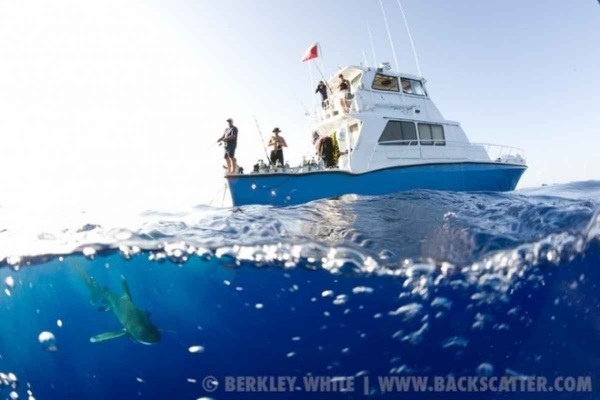
Dealing with Drops and Dribbles
Water spots on the dome are image killers, but Photoshop you can easily touch up a small spot or two. However, one small spot in a critical area takes a Photoshop master to repair. Best practice is to prevent drops in the first place. While I shoot both acrylic and glass domes, I alway choose glass for shooting splits as it’s less likely to collect water drops. Here are my favorite preparation techniques.
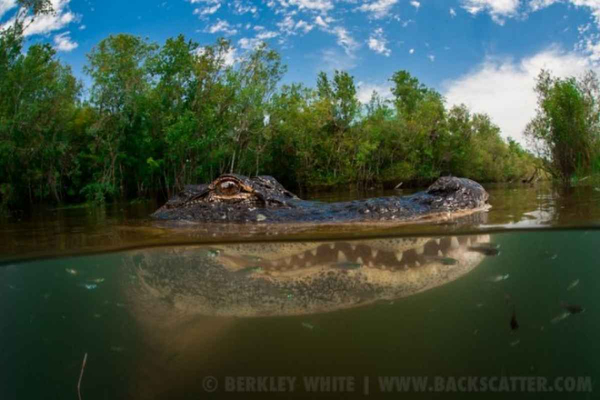
STEP 1: Polish Your Dome Before Every Session
Tiny mineral and even biological deposits adhere to your dome over the course of the day. Water drops cling to these particles in all the worst places. Before each session, I gently polish my glass dome with a soft plastic polish such as Novus number 2. Water will then sheet off the dome for a good half hour in the water.
STEP 2: Keep the Dome As Dry As Possible
Keep the top of your dome out of the water and as splash free as possible. If you’re working in very controlled conditions, blot water drops from the dome with a clean towel.
STEP 3: Dunk Before the Shot
Inevitably you’ll get the dome completely wet. After this happen simply dunk the entire dome in the water right before every shot. The goal is to shoot through the water while it’s sheeting off the dome. If spots become a problem, rub spit on your dome just like cleaning your mask. This will usually help extend your time before another cleaning is required.
Page 1: David Doubilet, Franco Banfi, Cristian Dimitrius, Allison Vitsky Sallmon and Andy Sallmon.
Page 2: Matt Smith, Douglas Seifert.
Page 3: Mike Veitch, David Fleetham, Eiko Jones.
Page 4: Viktor Lyagushkin, David Salvatori, Becky Kagan Schott.
Page 5: Rico Besserdich, Julian Cohen, Berkley White.